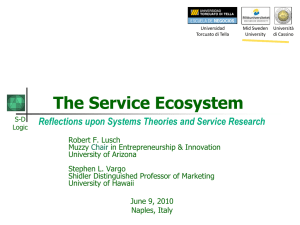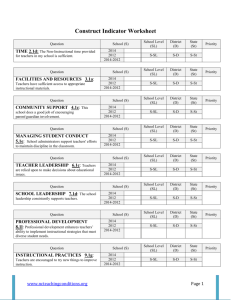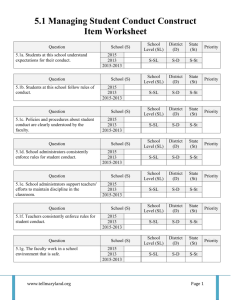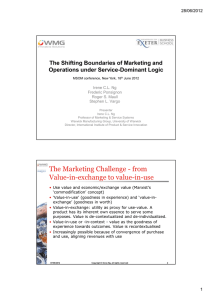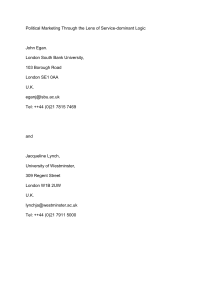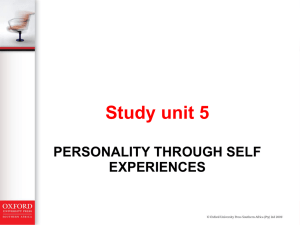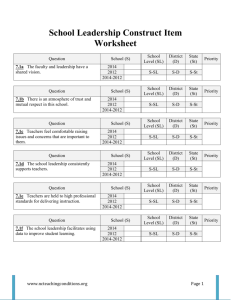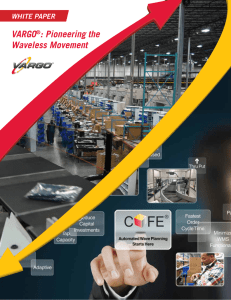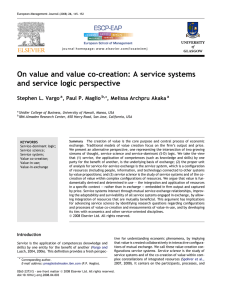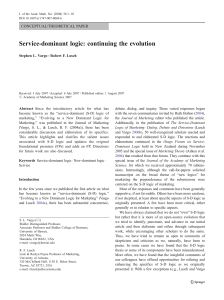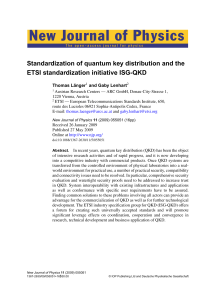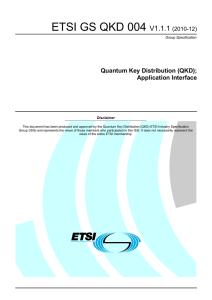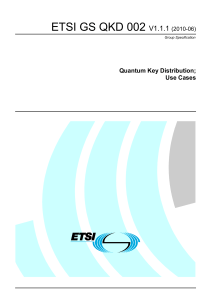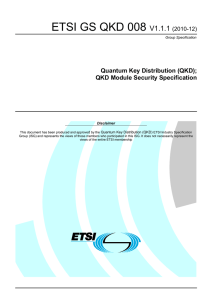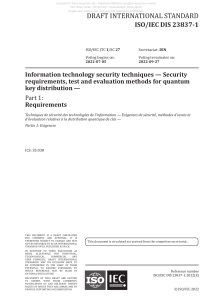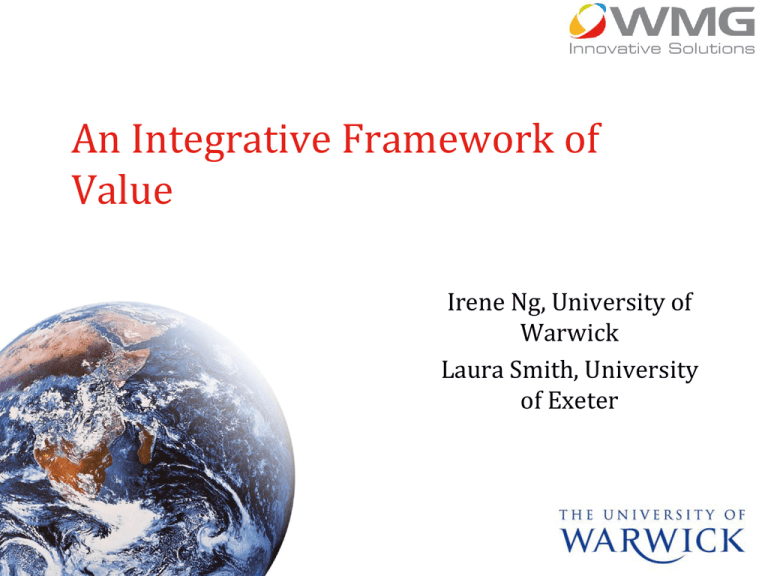
An Integrative Framework of
Value
Irene Ng, University of
Warwick
Laura Smith, University
of Exeter
Introduction
• Value is a concept discussed for over 2000 years
• Underpinned by marginal utility theory (Walras, 1894)
• Recently, there has been a shift from the primacy of “value-inexchange” to “value-in-use” e.g.
– ‘Marketing is the activity, set of institutions, and processes for creating,
communicating, delivering, and exchanging offerings that have value for
customers, clients, partners, and society at large.’ (AMA, 2007)
• Yet, the meaning and nature of value and the locus of its creation
continues to be contentious.
Our Aim:
• Through an extensive review of value literature on economics, choice
theory, consumption, management and marketing, we propose an
integrative framework of value
• We argue that the integrated framework of value proposed is a way
forward in understanding the future of marketing and new business
models.
Philosophical Foundations: Axiology
•
Value as Intrinsic vs. Instrumental (extrinsic) (Plato, 1930)
•
Lead to classification of value dimensions (e.g. Mattsson, 1992; Hartman, 1967:1973)
– E.g. Grandpa’s chair
Practical dimensions of a ‘seat’
Logical dimensions of ‘width, size or height’
Emotional dimension of being ‘great-grandpa’s
chair’
‘systemic value’ i.e. can seat a person without
falling over, since all good chairs share the same
property.
•
Axiological work based on Hartmann (1973) contrasts with the phenomenological
concept of value…
– The nature of value cannot be natural (Moore, 1993)
– ‘great-grandpa’s chair’ can only be of value as experienced (mentally or
physically) by the valuer within his/her consciousness (Husserl, 1939)
– Individuals and their contexts are mutually constitutive, i.e. they are partially
defined by one another (Giddens, 1979; Chandler and Vargo, 2011)
Economic Foundations
•
Philosophical foundations reflect debate on ‘use-value’, economics has
debated the primacy of ‘exchange-value’.
•
This debate has been discussed widely in S-D Logic papers (e.g. Vargo and
Lusch, 2004:2008; Vargo and Morgan, 2005)
•
Exchange value underpins traditional customer-firm relationship and is
characterised by an offering’s worth in exchange, where each party
exchanges one kind of value for another (Bagozzi, 1975).
•
The relationship between exchange and use value is complex and traverses
an important macro and aggregated level of markets.
•
The exchange value for an offering may not be merely driven by its use
value, but through the transaction by which the individual chooses the
offering
•
Such a transaction and how individuals choose is explored in the theory of
choice (Hargreaves et al., 1992).
•
The proxy for use-value within exchange transactions is often ‘utility’,
which denotes the relative satisfaction from the consumption of an offering.
Management Foundations
Customer Centric Approach
Firm Centric Approach
Value is…
Utility
Neumann & Morgenstern (1944); Nash, J.F. (1950);
Anand, P.(1993); Kreps, D.M. (1988); Fishburn, P. C.
(1970).
Economic worth of the customer
Haenlein et al. (2006); Hooper et al (2001); Lewis
(2006); Palmatier (2008); Schmitt et al. (2011);
Venkatesan and Kumar (2004)
Perceived Satisfaction
Band (1991); Berghman et al (2006); Day (1990); Gale
(1994); Matthyssens et al. (2006); Narver and Slater
(1990); Naumann (1995); Porter (1985); Vandermerwe
(1993)
Net benefit
Anderson and Narus (1998); Bolton and Drew (1991);
Butz and Goodstein (1996); De Rose (1991); Dodds et
al (1991); Gronroos (1997); ZeithamI (1988)
Means-end
Beverland and Lockshin (2003); Flint and Woodruff
(2001); Flint et al. (1997); Flint et al. (2002);
Parasuraman (1997); Woodruff (1997)
Phenomenological experience
Abbott (1955); Holbrook (1994; 1996; 1999; 2006);
Prahalad and Ramaswamy (2000; 2004); Schmitt
(1999; 2003);
The total satisfaction received by a consumer from consuming an
offering that is able to be measured relatively across persons and
through revealed preferences, trade-offs and willingness to pay.
Often discussed as Customer Lifetime Value (CLV), that is the net
present value of the future profit flow over a customer lifetime.
Superior value is often equated to exceeding customer expectation
of an offering’s quality and/or price.
The difference between the benefits and the costs or sacrifices
perceived to be associated with acquiring and consuming an
offering.
‘Value is the perceived preference for and evaluation of those
product attributes, attribute performances, and consequences
arising from use that facilitate (or block) achieving the customer's
goals and purposes in use situations.’ (Woodruff, 1997: P.142)
Value resides, not in an object, a product, or a possession but rather
in the use experience.
S-D Logic
•
S-D Logic re-proposes that value goes beyond simply the utility of an offering to
value as…
– Co-created
– Phenomenological experience
– Determined by the beneficiary (customer)
– Beneficiary (customer) is an active participant
•
Consequently, from a S-D Logic perspective, companies cannot provide value, but
merely offer propositions of value
•
However, current literature does not address how value of an offering could be
conceptualised at the point of choice, even if it is phenomenologically experienced at
the point of consumption.
•
The following discussion proposes an assimilation of various literature and presents
an integrated value framework.
Consciousness of Value
•
Value as phenomenological and uniquely co-created between an offering and an
individual may sit in different levels of consciousness at different times.
•
Block (1997) proposes two types of consciousness– phenomenal (P-consciousness)
and access (A-consciousness)
P-C-Value:
•
P-consciousness is the raw experience of movement, forms, sounds, sensations,
emotions and feeling
•
P-consciousness of value (P-C-value) is that which has been discussed in S-D Logic
literature and its extensions (e.g. Vargo et al., 2008; Chandler and Vargo, 2011; Payne
et al, 2008). It is the creation of value in context that is phenomenal, the raw
experience of creating value (goodness) in interactions around the experience.
A-C-Value:
•
A-consciousness is perception, instrospection, reflection, in a sense, a more
heightened awareness of a phenomenon.
•
A-consciousness of value (A-C-value) is the perception of goodness that drives choice
ex-ante and valuation ex-post.
The Integrated Value Framework
The Paradox of Value
•
Only one type of value is created: P-C-value
•
P-C-value cannot be truly known
•
When an individual assesses, evaluates and becomes conscious of P-C-value, it
becomes A-C-value
•
Therefore, measurement, assessment, judgement or evaluation of value can only
capture A-C-value
Implications
•
Segmentation, targeting and positioning could
be based on customer or offering
heterogeneity in the five elements of
experience, rather than on choice or benefits:
– Firms are starting to adapt their offerings
for different affordances, e.g. train
companies
– Promotion is beginning to leverage on
context through proximity marketing,
such as the foursquare app on the iPhone.
– marketing could go beyond channels of
purchase into channels of influences,
experiences, meanings, symbols.
– Price, a proxy of choice, is changing in its
nature. Market transactions are behaving
less like ‘what I get is what I paid for’. e.g.
using Google, Facebook, to obtain
nutritional attributes of food in the
supermarket by scanning the barcodes,
all of which the payment mechanism and
revenue distribution is unclear.
Why focus on context
• First, by focusing on contexts, we can focus on
contextual invariances - clusters of contexts that
are similar
• Second, because context is where value creation
happens, we need to understand contexts to
understand the way interactions happen and
could change with different products and
technology.
• Third, context is where the money is.
22/03/2016
Copyright © Irene Ng, all rights reserved
11
Creating new transactions/markets
• Normann correctly points out that technology
liberates us from constraints of
•
•
•
•
time, when things can be done
place, where things can be done
actor, who can do what
constellation, with whom it can be done
22/03/2016
Copyright © Irene Ng, all rights reserved
12
Context design in service –
theory/framework for the internet of
things
22/03/2016
WMG
13

